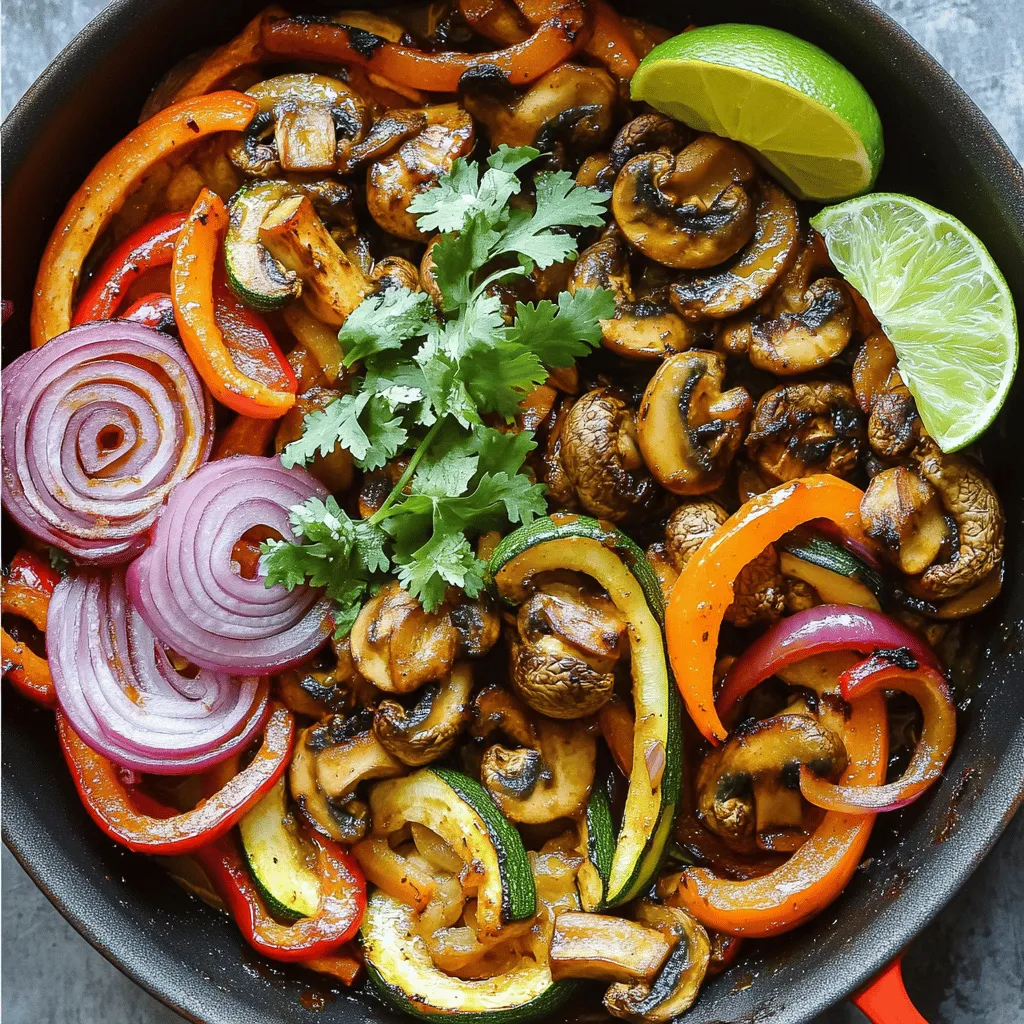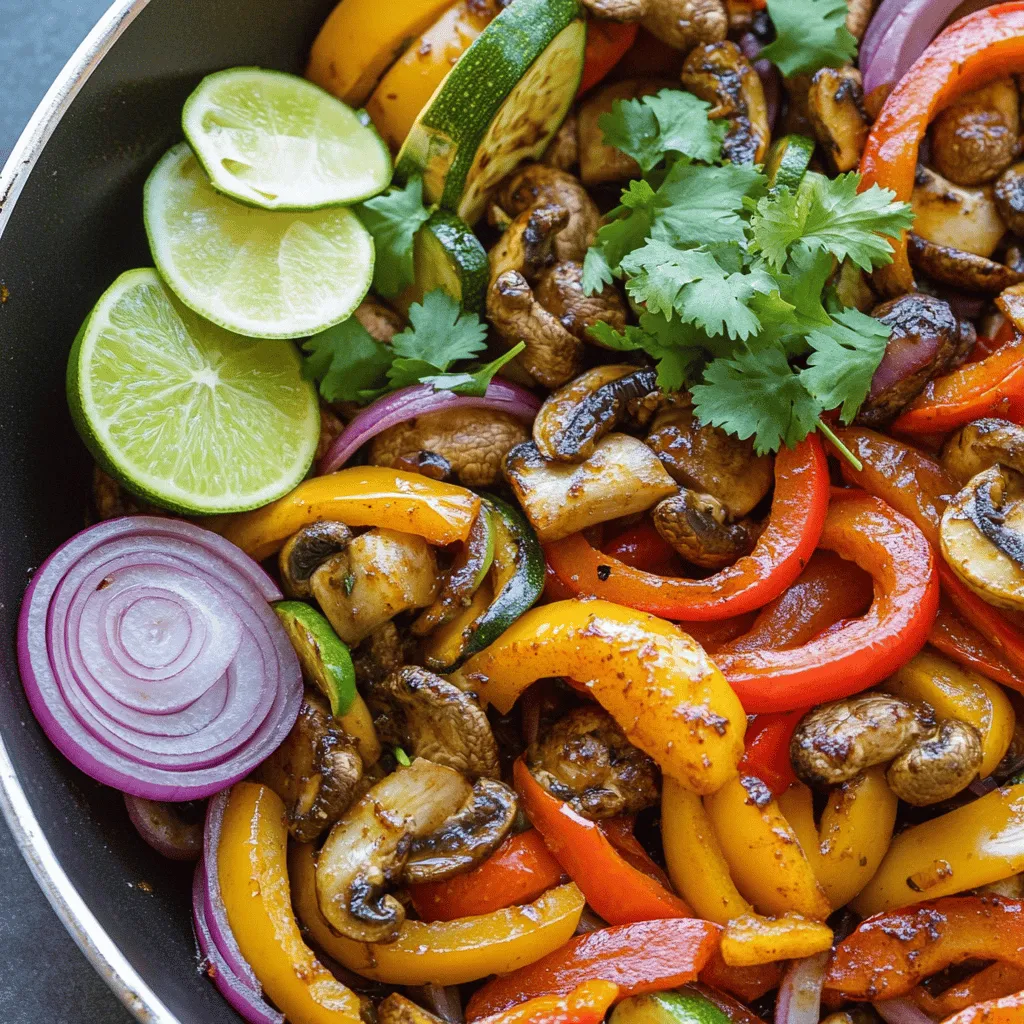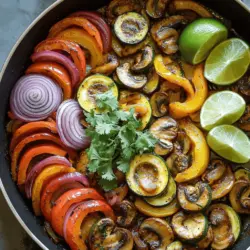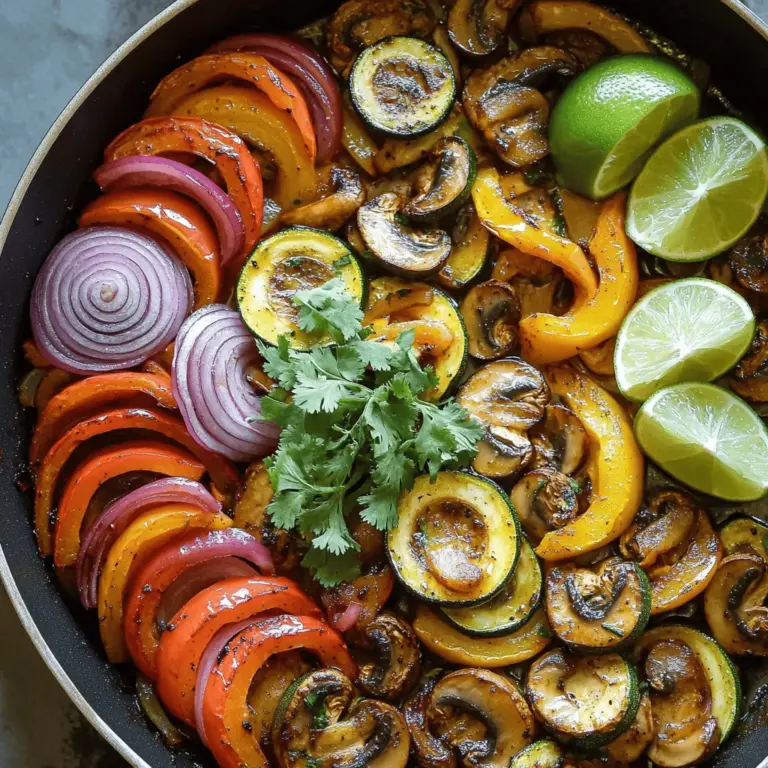Looking to spice up your meals? Fajita veggies are the answer! This guide will walk you through what makes the best fajita vegetables, how to prep them, and delicious ways to cook them. You’ll also discover creative uses for leftovers and why these veggies are a healthy choice. Join me as we explore this simple and flavorful recipe to brighten your dinner table!
What Ingredients Should You Use for Fajita Veggies?
For amazing fajita veggies, start with fresh vegetables. The best fajita vegetables include bell peppers, red onions, zucchinis, and mushrooms. Each brings a unique taste and texture.
What are the Best Vegetables for Fajitas?
I recommend using colorful bell peppers. They add sweetness and crunch. Red onions give a nice bite. Zucchini adds a soft, rich texture. Mushrooms bring an earthy flavor. You can use other veggies too. Try corn or asparagus for a twist.
How to Choose Fresh Ingredients for Your Fajita Veggies?
Look for firm vegetables. They should have bright colors. Avoid any with soft spots or blemishes. For bell peppers, choose ones with smooth skin. Fresh zucchini should feel heavy for its size. When you pick mushrooms, they should be dry and firm.
What Are Typical Fajita Toppings?
Toppings can make your fajitas special. Fresh cilantro adds a burst of flavor. Squeeze some lime juice for tanginess. You can also add shredded cheese, salsa, or avocado. Each topping brings its own taste to the dish.It will guide you through the steps to make these colorful and tasty fajita veggies!
How Do You Prepare Fajita Veggies at Home?
To make fajita veggies, start by gathering your ingredients. You need bell peppers, red onion, zucchini, and mushrooms.
What are the Steps for Making Fajita Veggies?
First, rinse and slice your vegetables. Use a sharp knife for clean cuts. Heat olive oil in a pan over medium-high heat. Add minced garlic and sauté for about 30 seconds. Next, toss in the sliced onions and cook for 2-3 minutes. They should soften slightly.
Now, add the bell peppers and cook for another 3-4 minutes. This step keeps them tender-crisp. Then, mix in the zucchini and mushrooms. Stir occasionally for about 5 minutes. Cook until all veggies are tender but not mushy. Finally, season with cumin, smoked paprika, chili powder, salt, and pepper. Stir for 2-3 minutes to blend the flavors.
How to Prep Your Vegetables for Cooking?
Prepping your vegetables is key. Start by washing them well. Then, slice each vegetable evenly. This helps them cook at the same rate. For bell peppers, remove the seeds and cut into strips. For zucchini, slice them into half-moons. Keep the slices thin, so they cook quickly.
Onions should be thinly sliced for quick cooking. Lastly, mushrooms can be sliced into rounds. Place all the sliced veggies in one bowl for easy access while cooking.
Can You Use Frozen Fajita Veggies?
Yes, you can use frozen fajita veggies. They are convenient and save time. Just remember to thaw them before cooking. Drain any excess water to avoid sogginess. Sauté them in the same way as fresh veggies. The key is to cook them long enough to heat through. Enjoy the ease of using frozen options while still enjoying great flavor!

What Cooking Methods are Best for Fajita Veggies?
Fajita veggies are quick, easy, and packed with flavor. You can use several cooking methods to make them. Each method gives a unique taste and texture.
How to Sauté Fajita Veggies for Maximum Flavor?
To sauté fajita veggies, heat a large skillet over medium-high heat. Add olive oil, then toss in minced garlic. Cook it for 30 seconds until it smells great. Next, add sliced red onion and cook for 2-3 minutes. This makes the onion soft. Then, mix in bell peppers. Cook them for 3-4 minutes until they are tender-crisp. Finally, add zucchini and mushrooms. Stir and cook for about 5 minutes. This keeps them crunchy. Season with cumin, smoked paprika, and chili powder. Stir well, then cook for another 2-3 minutes. This brings all the flavors together.
What is the Best Way to Roast Fajita Veggies?
Roasting fajita veggies in the oven is simple. Preheat your oven to 425°F (220°C). Toss your veggies with olive oil and seasonings. Spread them on a baking sheet in a single layer. Roast for about 20-25 minutes. Stir halfway to ensure even cooking. This method gives veggies a nice caramelized flavor and a bit of crispness.
Can You Grill Fajita Veggies for a Smoky Flavor?
Yes, grilling is a great way to add a smoky flavor to fajita veggies. Preheat your grill to medium-high heat. Toss your sliced veggies with olive oil and seasonings. Place them in a grill basket or wrap them in foil. Grill for about 10-15 minutes, stirring occasionally. You will get those lovely grill marks and a smoky taste.
Fajita veggies are versatile and fun to cook.Enjoy your cooking!
How Can You Enhance the Flavor of Fajita Veggies?
To make fajita veggies pop, you need the right seasonings. The best seasonings for fajita veggies include ground cumin, smoked paprika, and chili powder. These spices give your dish depth and warmth. Salt and pepper are also key to balance out the flavors.
You can create your own homemade fajita seasoning. Mix two tablespoons of chili powder, one teaspoon of cumin, and one teaspoon of smoked paprika. Add ½ teaspoon of garlic powder and salt to taste. This blend works great and tastes fresh.
If you want to spice things up, consider adding cayenne pepper or crushed red pepper flakes. These add heat without overpowering the other flavors. You can also try using fresh jalapeños for an extra kick. Slice them thin and add them with your veggies.It’s easy and quick to make. Just remember, the right seasoning makes all the difference. Enjoy your flavorful dish!

What are Some Creative Uses for Leftover Fajita Veggies?
When I cook fajita veggies, I often have extras. These leftover fajita veggies can shine in many dishes. You can use them in breakfast tacos. Just add eggs and wrap it all in a tortilla. It’s a quick and tasty meal to start your day.
Another idea is to toss them in salads. Fajita veggies add color and flavor to greens. They pair well with a tangy dressing and some cheese. This makes for a fun and filling lunch.
You can also make a veggie quesadilla. Just layer leftover fajita veggies with cheese between tortillas. Cook until golden brown, and you have a delicious snack or meal.
If you want something warm, try adding them to soup. They can boost the flavor of vegetable or bean soup. Just stir them in while the soup simmers.
For meal prep, fajita veggies are a great choice. You can divide them into containers with grains and protein. This makes for a balanced meal ready to go. Remember, they can stay fresh for up to four days in the fridge.
Incorporating leftover fajita veggies into other meals is easy. You can add them to pasta, rice, or even pizza. Their smoky flavor brings life to any dish. So, don’t toss them out. Use your leftover fajita veggies to create something new and exciting!
What Makes Fajita Veggies a Healthy Choice?
Fajita veggies are a great choice for anyone looking to eat healthy. They are packed with vitamins and minerals. The mix of bell peppers, onions, zucchini, and mushrooms adds color and nutrition to your plate. Each veggie brings unique nutrients that help keep you well.
What Nutritional Benefits Do Fajita Veggies Offer?
Fajita veggies provide many health benefits. Bell peppers are high in vitamin C. They help boost your immune system. Onions contain antioxidants that fight inflammation. Zucchini is low in calories and full of water, keeping you hydrated. Mushrooms add fiber and can support your gut health. Eating a variety of these veggies ensures you get a balance of nutrients.
How Many Calories Are in Fajita Veggies?
A serving of fajita veggies has about 100 calories. This is a low-calorie option for any meal. You can enjoy them in wraps or as a side dish without worrying about extra calories. The olive oil adds healthy fats, but use it in moderation to keep calories in check.
How Can You Make Fajita Veggies Even Healthier?
You can make fajita veggies healthier by using less oil. Instead of two tablespoons, try one tablespoon of olive oil. You can also add more vegetables to your dish. Spinach or kale can boost the nutrient content. For added protein, toss in some black beans or chickpeas. This makes the meal more filling and nutritious.
How Do You Prepare Fajita Veggies at Home?
To prepare fajita veggies at home, follow these simple steps. First, gather your fresh ingredients. You’ll need bell peppers, red onions, zucchini, and mushrooms. This mix gives a nice color and flavor.
Next, rinse and slice all the veggies. Cut the bell pepper into strips and the zucchini into half-moons. Thinly slice the red onion and mushrooms. Having them ready makes cooking easier.
Now, heat a large skillet over medium-high heat. Add two tablespoons of olive oil. Once it’s hot, add minced garlic and stir it for about 30 seconds. This step brings out the garlic’s great flavor.
Then, toss in the sliced red onion. Cook for 2-3 minutes until it softens. After that, add your bell peppers. Sauté for another 3-4 minutes until they are tender-crisp.
Next, add zucchini and mushrooms to the pan. Stir the mix every so often. Cook for about 5 minutes. You want the veggies to be cooked but still crunchy.
Now it’s time to season! Sprinkle ground cumin, smoked paprika, chili powder, salt, and pepper over the veggies. Stir well and cook for another 2-3 minutes. This step helps the flavors blend nicely.
Finally, remove the skillet from the heat. Garnish with fresh chopped cilantro. Serve with lime wedges for a zesty touch.Enjoy your flavorful fajita veggies!
Fajita veggies are simple to make and packed with flavor. We discussed the best ingredients, cooking methods, and how to elevate their taste. You learned how to use fresh vegetables and seasonings to create a delightful dish. Don’t forget to try new ways to use leftovers, too. These veggies are not just tasty; they are also healthy. Enjoy making your fajitas vibrant and full of life! Keep experimenting and have fun in the kitchen.



